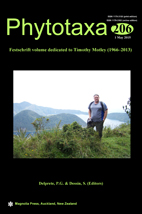Abstract
The Henriquezieae-Posoquerieae-Sipaneeae clade (Rubiaceae) is centered in the Guayana Region of Northern South America. The Henriquezieae and Sipaneeae contain a large number of taxa that are endemic to the Guayana Region, while the Posoquerieae exhibits a wider distribution throughout the Neotropics. In order to evaluate the phylogenetic relationships within this clade, and assess the evolution of selected morphological characters potentially important in its diversification, we performed parsimony analyses of ITS, trnL-F, rps16 and morphology, Bayesian Markov chain Monte Carlo analyses of the molecular data, and optimized six morphological characters on cpDNA trees. Results confirm the monophyly of each of the tribes, and that of the genera included in the study. The Sipaneeae are the earliest diverging lineage, sister to a well-supported Henriquezieae-Posoquerieae clade. Henriquezieae have many traits unique or atypical in Rubiaceae, a tendency observed in other lineages endemic to the Guayana Region, suggesting strong selection for morphological novelties necessary to colonize the extremely poor soils of this region. The pollen catapult mechanism originated in the Molopanthera-Posoqueria clade is perhaps unique in angiosperms, and may represent a novel strategy that played an important role in the early divergence that gave rise to both genera, and to the early radiation of the genus Posoqueria. Diversification of Posoqueria outside the Guayana Region probably was accompanied by a shift from capsular to baccate fruits that facilitated colonization of understory forests. Habit specialization may be considered a consistent factor in the diversification of the Guayanan-centered clade of the Rubiaceae.

